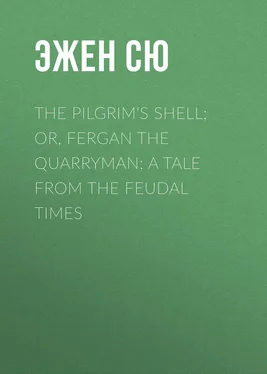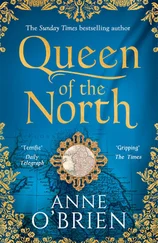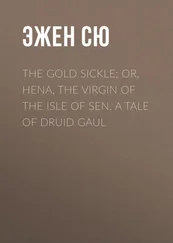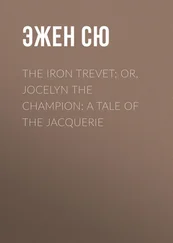Эжен Сю - The Pilgrim's Shell; Or, Fergan the Quarryman - A Tale from the Feudal Times
Здесь есть возможность читать онлайн «Эжен Сю - The Pilgrim's Shell; Or, Fergan the Quarryman - A Tale from the Feudal Times» — ознакомительный отрывок электронной книги совершенно бесплатно, а после прочтения отрывка купить полную версию. В некоторых случаях можно слушать аудио, скачать через торрент в формате fb2 и присутствует краткое содержание. Издательство: Иностранный паблик, Жанр: literature_19, foreign_antique, foreign_prose, на английском языке. Описание произведения, (предисловие) а так же отзывы посетителей доступны на портале библиотеки ЛибКат.
- Название:The Pilgrim's Shell; Or, Fergan the Quarryman: A Tale from the Feudal Times
- Автор:
- Издательство:Иностранный паблик
- Жанр:
- Год:неизвестен
- ISBN:нет данных
- Рейтинг книги:3 / 5. Голосов: 1
-
Избранное:Добавить в избранное
- Отзывы:
-
Ваша оценка:
- 60
- 1
- 2
- 3
- 4
- 5
The Pilgrim's Shell; Or, Fergan the Quarryman: A Tale from the Feudal Times: краткое содержание, описание и аннотация
Предлагаем к чтению аннотацию, описание, краткое содержание или предисловие (зависит от того, что написал сам автор книги «The Pilgrim's Shell; Or, Fergan the Quarryman: A Tale from the Feudal Times»). Если вы не нашли необходимую информацию о книге — напишите в комментариях, мы постараемся отыскать её.
The Pilgrim's Shell; Or, Fergan the Quarryman: A Tale from the Feudal Times — читать онлайн ознакомительный отрывок
Ниже представлен текст книги, разбитый по страницам. Система сохранения места последней прочитанной страницы, позволяет с удобством читать онлайн бесплатно книгу «The Pilgrim's Shell; Or, Fergan the Quarryman: A Tale from the Feudal Times», без необходимости каждый раз заново искать на чём Вы остановились. Поставьте закладку, и сможете в любой момент перейти на страницу, на которой закончили чтение.
Интервал:
Закладка:
The manor of Plouernel raises its front on the summit of a rocky and arid mountain, washed on its western slope by a swift running stream, while on the east it beetles over a narrow path constructed over immense marshes, drained by a canal that feeds the vast ponds of the abbey of Meriadek, located several leagues off, and one time part of the large holdings of the diocese of Nantes. If a traveler follows the overland route he is compelled to cross this jetty on his way from Angers to Nantes, unless he be willing to make a wide detour by journeying over the domains of the seigneur of Castel-Redon. The vessels that sail into the Loire through the river of Plouernel, whose waters bathe the foot of the hills, pass close under the castle. The location of the lair is skilfully chosen. It dominates the two only routes of communication between the most important towns of the region. A stockade half bars the river of Plouernel, and serves as a shelter for the barges of the seigneur. Merchant vessels being signaled from the top of the donjon, men in arms immediately embark, board the trader, collect navigation dues, and not infrequently pillage the cargo. No less dangerous is the overland route. A palisade, into which a gate is cut, bars the passage. It can be crossed only upon paying a toll, arbitrarily imposed upon the travelers by the count's men, who, moreover, sack the baggages at their ease. If they suspect a traveler of being able to pay ransom they drag him to prison and there torture him until he consents to ransom himself. The ill-starred ones who may be too poor to pay the toll demanded are, both men and women, forced to submit to obscene affronts, ridiculous or cruel, to the great amusement of the men of the seigneur. On one of the gentler slopes of the mountain, towards the north, the little city of Plouernel rises in tiers, built in a semi-circle and equidistant from the manor and the valley, where lie scattered the villages that the villeins and serfs inhabit. A narrow path, winding and steep, and bordered here and yonder by precipices, leads up to the first fortified enclosure, whose ramparts, thirty feet high by two feet thick and flanked with large towers of brick, constitute one mass with the rock that serves as their foundation, a rock hewn with the pick and surrounded by abysses. The dizzy path that winds above the precipices ends in a massive door covered with iron sheets and enormous nails. It is the only access to the interior of the first enclosure, a somber court, where the sun penetrates only at noon, being otherwise kept out by the height of the numerous structures that lean from within upon the ramparts. These structures are intended for the lodgement of the men-at-arms, for the masons, the chapel, the bakery, the forge and several other workshops – a mint among them. The Count of Plouernel coined money like the other feudal seigneurs, and, like them, he minted it to his liking. In the center of the court rises the principal donjon. That building, square, over a hundred feet high, crowned with a platform from which the country is far away disclosed, rests upon three tiers of subterraneous cells, surrounded by a ditch full of water furnished from springs that also serve as cisterns. The donjon seems to rise from the midst of a deep pit, in which half of this massive structure appears hidden, its upper part rising merely above the skirt of the ditch, over which falls a draw bridge. Few and narrow windows, irregularly cut into the four sides, and almost as narrow as mere loop-holes, yielded a gloomy light to the several stories and to the ground floor. The stonework of all these buildings, blackened by the inclemencies of the weather and by age, rendered still more dismal the aspect of this fortress.
CHAPTER V.
AZENOR THE PALE
A narrow spiral staircase, built of stone, led from the bottom of the basement to the platform that surmounted the donjon of the manor of Plouernel. The men at arms, charged with the lookout on the platform, never failed to cross themselves when passing the door of an alcove, situated on the last story of the donjon, that had for its annex one of the turrets that rose from the four corners of the platform. It was whispered that the narrow window of that turret seemed internally illuminated at night by a glow of the color of blood, and these sinister lights were attributed to the sorceries of Azenor the Pale, the concubine of Neroweg VI. The seigneur of Plouernel had gathered in the chamber of his mistress a mass of precious objects, the fruits of his raids. A passage, concealed by a purple curtain, fringed with gold, gave admission to another turret, whose upper part, roofed on a level with the platform, served as the post for the lookout. Azenor the Pale, about twenty-five years of age, was of a perfect beauty. Her face was pale and her sensuous lips were the color of her skin, whence her surname. A turban of rich purple silk fabric in the shape of a chin-cloth, served as a frame for the visage of the sorceress, while it left exposed the strands of her hair, black like her eyebrows and her large eyes. Her tunic of silver cloth was negligently thrown over her shoulders. Her bosom and arms were worthy of figuring beside that beautiful Greek statue that has survived the centuries, and which, rumor has it, is still admired in the palace of the Dukes of Aquitaine. The tunic of Azenor, reaching only to her knees, left exposed below its silver folds the skirt of her dress, purple like her turban. The woman was at this moment engaged in molding a bit of pliable wax into two little figures similar to the one inserted that very morning between the teeth of Pierrine the Goat at the moment of her death agony. One of the puppets wore a bishop's robe, the other a species of armor represented by a dull-colored bit of cloth resembling iron. Azenor the Pale was inserting a certain number of needles, disposed in cabalistic order, on the left side of the breast of the two puppets, when the door of the alcove opened behind her. Neroweg VI. entered his mistress' retreat, carefully closing the door after him.
The Count of Plouernel, surnamed "Worse than a Wolf," and at that time about fifty years of age, was of athletic frame. His hair no longer was dressed after the fashion of his ancestor, the Neroweg, leude of Clovis, nor after that of Neroweg, the "Terrible Eagle," savage chief of a savage tribe. The red hair of Neroweg VI., already grizzled, was shaven smooth to the middle of the temples and the skull, and then fell square down his neck and behind his ears. The men of war had themselves thus shaven in front to prevent their hair from interfering with their casque and standing in the way of the visor. Instead of cultivating long moustaches, like his ancestors, Neroweg VI. allowed to grow at full length only his thick and coarse beard, which thus framed in his savage countenance and his hooked nose. His heavy eyebrows met over his falcon eyes, round and piercing. Always ready for war upon his neighbors, or upon those troops of travelers that, at times, attempted to offer forcible resistance to the brigandage of the seigneurs, Neroweg VI. wore a casque, which he laid by on entering. His jacket and buff hose disappeared under a hauberk or iron coat of mail, held to his waist by a leathern belt, from which hung two swords, the shorter one at his right, the longer at his left. The hauberk guarded his arms down to the gauntlets, and fell slightly below his knees, which, like his legs, were protected by iron greaves, held together with leathern thongs. The face of Neroweg VI. betrayed a gloomy and troubled mind. Azenor the Pale, still engaged in inserting the needles into the left sides of the wax figures, was murmuring certain words in a strange tongue, and seemed not to notice the arrival of the Count. He drew slowly near, and said in a hollow voice: "Well, now, Azenor, is the philter ready?"
Читать дальшеИнтервал:
Закладка:
Похожие книги на «The Pilgrim's Shell; Or, Fergan the Quarryman: A Tale from the Feudal Times»
Представляем Вашему вниманию похожие книги на «The Pilgrim's Shell; Or, Fergan the Quarryman: A Tale from the Feudal Times» списком для выбора. Мы отобрали схожую по названию и смыслу литературу в надежде предоставить читателям больше вариантов отыскать новые, интересные, ещё непрочитанные произведения.
Обсуждение, отзывы о книге «The Pilgrim's Shell; Or, Fergan the Quarryman: A Tale from the Feudal Times» и просто собственные мнения читателей. Оставьте ваши комментарии, напишите, что Вы думаете о произведении, его смысле или главных героях. Укажите что конкретно понравилось, а что нет, и почему Вы так считаете.












